新目标七年级英语下第三单元sectionB词汇和语法教学文案
- 格式:doc
- 大小:46.00 KB
- 文档页数:7
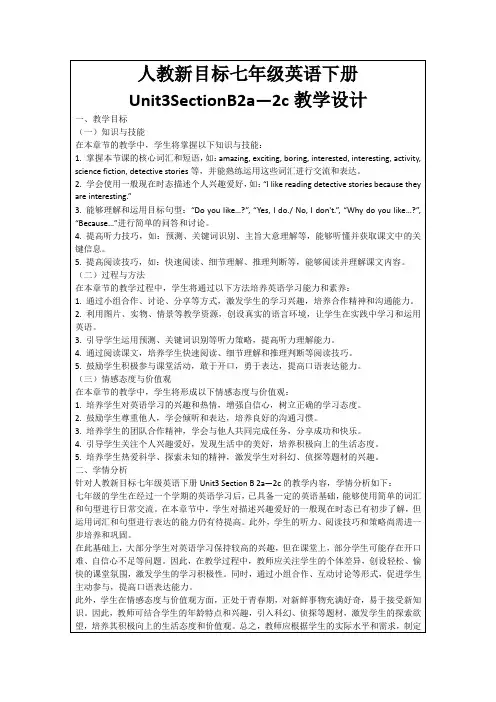
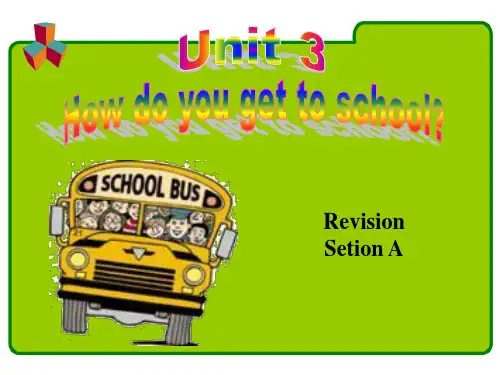


新目标英语七年级下册第三单元说课稿Interpretation for Section B , 2a to 2c of Book 7B , Unit 3Xu Hongshan , Taipingdian Middle SchoolGood morning , everyone! I’m Xu Hongshan from Taipingdian Middle School Of Xiangyang . I'm very glad to be here to interpret my lesson , the lesson I'm going to interpret is from Unit 3 of Go for it ! Book 7B . Now I’ll talk about How I’m going to teach 2a to 2c of Section B . I’ll interpret the lesson from four parts .Part One : Analysis of the Teaching MaterialI . Status and Function1.This is an important lesson in Unit 3 . From this lesson , it asks the Ss to grasp contents of the reading passage , to attain reading , speaking and writing skills . It tells the Ss to remember the new words and use the Present Simple Tense , It prepares Ss to write about how to get to places using the target language . Therefore , this lesson is in the important position of the teaching material .2.This period is the third one of Unit 3 . So if the Ss can learn it well , it will be helpful to make the Ss master this unit .3.Such a topic is related to daily life , so it is helpful to raise learning interests of Ss and it will also be helpful to improve their reading and writing skills .II . Analysis of the StudentsThe Ss have learned target language talking about how to get to places . So they can understand most of the reading passage . This text will talk about a schoolboy in a village . So they may take a great interest in the reading .III . Learning GoalsThe learning goal s’ basis is established according to Junior School English syllabus’ provision .1 . Knowledge goals :(1)To make the Ss able to read , write and use the new words and phrases :Words : cross , river , many , village , between and bridge , boat , ropeway , year , afraid , like , villager , leave , dream , true Phrases : come true , be like , go on a ropeway , cross the river , etc.(2)To make the students able to understand the meaning and use of the following sentence structures :It’s + adj + to do sth , & There be . The first one is used very often so it’s important . We have to pay special attention to the “There-be” structure although it just occurs for the first time .2.Ability objects :To help the Ss understand the text and improve their reading strategies by finishing the reading comprehensive Exx .3.Moral objects :To value our happy life since there are still so many poor people in our country .IV . Teaching Key Points and DifficultiesHere their basis is established according to the teaching material's position and function .1.Key points :(1)To help the Ss to memorize the new words and expressions .(2)To enable the Ss to understand the reading passage .(3)To draw the Ss’ interest in English .2.Difficulties :How to improve their reading skills and strategies . As weknow , reading is very important in our English studies and tests , especially for the Ss from rural areas .V . Teaching AidsMulti-media computer , Tape recorder , Software : Power point . They will be needed in this lesson and help Ss to understand better .Part Two : The Teaching Methods1 . 5-P teaching methods .2 . 3-research and 4-study teaching and learning model .3 . 3-step reading teaching method .As we all know , the 5-P English teaching method has been used in China for many years and gained great success . It’s proved that this English teaching method is very helpful to improve the Ss’English learning , because it can do a lot when helping the Ss learn and master what they’re learning . The 3-research and 4-study teaching and learning model has been brought in Fancheng for no more than two years , but we can find it very efficient in developing the Ss’abilities . As for the 3-step reading teaching method , it follows the language learning rules and it helps improve the Ss’ reading efficiencies . In my opinion , they are just the same in developing the Ss . So this class I’ll use both the teaching methods . I hope they can be mixed together and help us a lot . All in all , I’ll use the 5-step teaching method in warming-up , leading-in , practicing and exchange exhibition . Because I want this method to help the Ss learn and practice better .As for reading , I’ll follow the 3-step reading teaching method : Before reading , while reading and after reading . I’ll use the other model in pair work and group work . Because I want my Ss to improve their research and co-operation abilities .Part Three : Studying Ways :1. Encourage the Ss to be successful language learners .2. S tudy language in the way “Listening & Observation - reading - Practice - Production -1Examination” .3. Teach the Ss how to read more efficiently and how to write using the target language .Teaching special features:Let the Ss communicate with each other and hold competition among groups to develop the Ss’ keen interest in English .Part Four : Teaching ProcedureI’ll finish this lesson in f ive steps . First I’ll bring a competition into the class. At last let’s see which group is the winner .Step1 PreparationHave a free talk between T and Ss using “How far , How and How long” In this way , the Ss can be reminded of what they’ve learned in this unit .Step2 PresentationThis course is very important. I’ll mainly talk about this step.I’ll use ppt t o present these new words and phrases : go on a ropeway , cross the river , afraid ;I’ll use stick-pictures to present the following new words : between , bridge , boat , year ;They’ll find out these new words with the help of the guiding paper : like , villager , leave , dream , come true , be like Word studying is very important in English learning . But the Ss often find it boring to memorize the words . So making it livelyand interesting will be very helpful . To tell the truth , Grade 7 students are still so young that they can’t concentrate on studying for long . So it’s our duty to draw their interests in English studying .Then they’ll show their pronouncing in groups and see which group is the most active and pronounces the most exactly . This is a part of the competition .Step3 Reading (Practice)Only reading with purpose is efficient reading . So first they’ll read the text themselves and find the answers to the questions one by one .Next while reading , they’ll have to find some key sentences with the help of the guiding paper , such as “It is easy to get to school .” and “He’s like a father to me .” In this way , they’ll understand the text better .After reading , they’ll check each other’s answers and explain each other’s problems . If ther e are still problems , they can ask other groups for help . And I’ll help them if needed .Then do the same to 2c .As for the purpose of my designing , this step is set to make the Ss understand the text and the language points themselves . So the Ss will have a chance to improve their own reading abilities .Of course , after that , they will repeat after the tape to consolidate the language points .Step4 ProductionIn this step I’ll give the Ss free space to show their abilities . they’ll retell the who le text using some key words and phrases . In this way , they can improve their speaking and writing abilities . Showing ways may vary . They can retell individually or in groups .Retelling is a good way to train the Ss’ reading and speaking abilities . If they can retell the story fluently , it shows that they have been familiar with the text .Step 5 ProgressIn general , they’ll have a test in this step to check how they’ve learned . I’ll check in two ways : The first is to let the Ss summarize the usages of the language points and give some examples .某人做某事怎么样?(句型结枸)害怕的(用法)There be (某处有某物)句型用法Be like(像什么一样)The second way is to let the Ss complete some sentences using the target language .1 . It’s not easy (横跨河流上学) (cross)2 . you (你害怕吗)?(afraid)3 . Can (他能实现他的梦想吗)?(come)Blackboard DesignLearning goals :1 . I’ll be able to read , write and use the new words and phrases : cross , river , many , village , between and bridge , boat , ropeway , year , afraid , like , villager , leave , dream , true ; go ona ropeway , be like , come true , cross the river ;2 . I’ll be able to use the following sentence structures in expressing :It’s + adj. + (for sb.) + to do sth. . / There be … .3 . I’ll be able to improve my reading abilities through reading practice .That's all for my interpretation, thank you for your attention !2013.10.122。
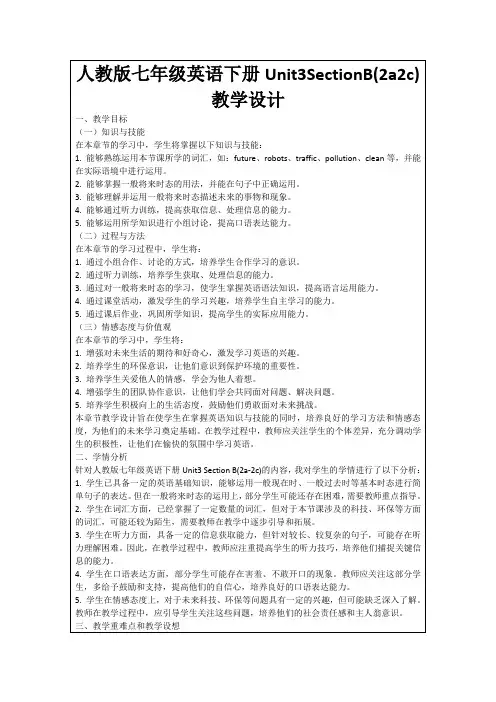
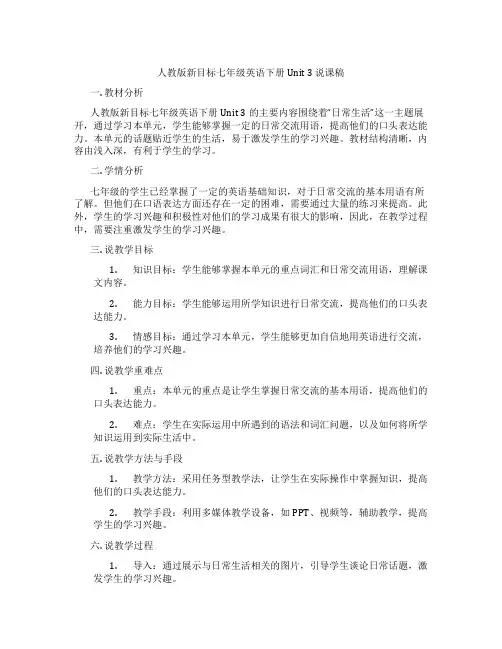
人教版新目标七年级英语下册 Unit 3 说课稿一. 教材分析人教版新目标七年级英语下册Unit 3的主要内容围绕着“日常生活”这一主题展开,通过学习本单元,学生能够掌握一定的日常交流用语,提高他们的口头表达能力。
本单元的话题贴近学生的生活,易于激发学生的学习兴趣。
教材结构清晰,内容由浅入深,有利于学生的学习。
二. 学情分析七年级的学生已经掌握了一定的英语基础知识,对于日常交流的基本用语有所了解。
但他们在口语表达方面还存在一定的困难,需要通过大量的练习来提高。
此外,学生的学习兴趣和积极性对他们的学习成果有很大的影响,因此,在教学过程中,需要注重激发学生的学习兴趣。
三. 说教学目标1.知识目标:学生能够掌握本单元的重点词汇和日常交流用语,理解课文内容。
2.能力目标:学生能够运用所学知识进行日常交流,提高他们的口头表达能力。
3.情感目标:通过学习本单元,学生能够更加自信地用英语进行交流,培养他们的学习兴趣。
四. 说教学重难点1.重点:本单元的重点是让学生掌握日常交流的基本用语,提高他们的口头表达能力。
2.难点:学生在实际运用中所遇到的语法和词汇问题,以及如何将所学知识运用到实际生活中。
五. 说教学方法与手段1.教学方法:采用任务型教学法,让学生在实际操作中掌握知识,提高他们的口头表达能力。
2.教学手段:利用多媒体教学设备,如PPT、视频等,辅助教学,提高学生的学习兴趣。
六. 说教学过程1.导入:通过展示与日常生活相关的图片,引导学生谈论日常话题,激发学生的学习兴趣。
2.新课呈现:讲解本节课的重点词汇和日常交流用语,让学生进行实际操作,如角色扮演等。
3.课堂练习:设计一些日常交流的场景,让学生进行实际运用,巩固所学知识。
4.课堂小结:对本节课的内容进行总结,让学生明确学习目标。
5.课后作业:布置一些与日常生活相关的任务,让学生课后进行练习,提高他们的口头表达能力。
七. 说板书设计板书设计要清晰、简洁,能够突出本节课的重点内容。
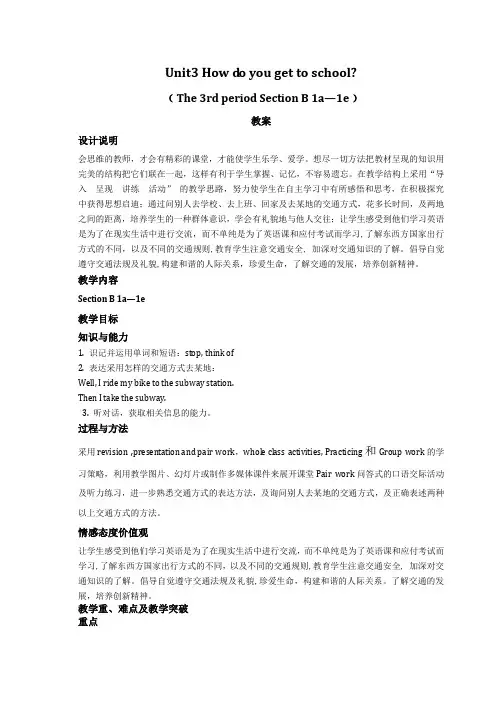
Unit3 How d o you get to school?﹙The 3rd period Section B 1a—1e﹚教案设计说明会思维的教师,才会有精彩的课堂,才能使学生乐学、爱学。
想尽一切方法把教材呈现的知识用完美的结构把它们联在一起,这样有利于学生掌握、记忆,不容易遗忘。
在教学结构上采用“导入---呈现---讲练---活动”的教学思路,努力使学生在自主学习中有所感悟和思考,在积极探究中获得思想启迪;通过问别人去学校、去上班、回家及去某地的交通方式,花多长时间,及两地之间的距离,培养学生的一种群体意识,学会有礼貌地与他人交往;让学生感受到他们学习英语是为了在现实生活中进行交流,而不单纯是为了英语课和应付考试而学习,了解东西方国家出行方式的不同,以及不同的交通规则,教育学生注意交通安全, 加深对交通知识的了解。
倡导自觉遵守交通法规及礼貌,构建和谐的人际关系,珍爱生命,了解交通的发展,培养创新精神。
教学内容Section B 1a—1e教学目标知识与能力1. 识记并运用单词和短语:stop, think of2. 表达采用怎样的交通方式去某地:Well, I ride my bike to the subway station.Then I take the subway.3. 听对话,获取相关信息的能力。
过程与方法采用revision ,presentation and pair work,whole class activities, Practicing和Group work的学习策略,利用教学图片、幻灯片或制作多媒体课件来展开课堂Pair work问答式的口语交际活动及听力练习,进一步熟悉交通方式的表达方法,及询问别人去某地的交通方式,及正确表述两种以上交通方式的方法。
情感态度价值观让学生感受到他们学习英语是为了在现实生活中进行交流,而不单纯是为了英语课和应付考试而学习,了解东西方国家出行方式的不同,以及不同的交通规则,教育学生注意交通安全, 加深对交通知识的了解。
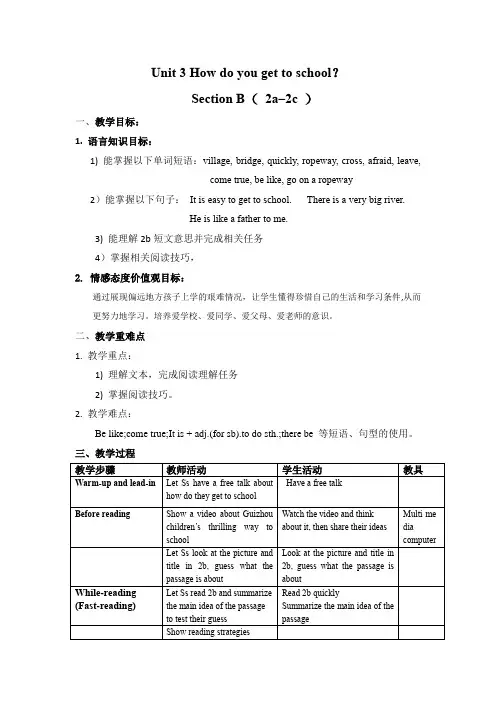
Unit 3 How do you get to school?
Section B(2a–2c )
一、教学目标:
1. 语言知识目标:
1) 能掌握以下单词短语:village, bridge, quickly, ropeway, cross, afraid, leave,
come true, be like, go on a ropeway 2)能掌握以下句子:It is easy to get to school. There is a very big river.
He is like a father to me.
3) 能理解2b短文意思并完成相关任务
4)掌握相关阅读技巧,
2. 情感态度价值观目标:
通过展现偏远地方孩子上学的艰难情况,让学生懂得珍惜自己的生活和学习条件,从而更努力地学习。
培养爱学校、爱同学、爱父母、爱老师的意识。
二、教学重难点
1. 教学重点:
1) 理解文本,完成阅读理解任务
2) 掌握阅读技巧。
2. 教学难点:
Be like;come true;It is + adj.(for sb).to do sth.;there be 等短语、句型的使用。
三、教学过程
do to help them?
Let Ss try to retell the passage
according to the mind-map.
Lead Ss to summarize the 附件:Mind-map。

Unit 3 How do you get to school?Section B (1a-1e)一、教学目标1. 词汇:stop2. 句型:—How do you get to school?—Well, I ride my bike to the subway station. Then I take the subway.3. 功能:询问和谈论出行方式。
4. 听:能捕捉细节信息的能力和叙述较复杂事情的能力。
5. 了解东西方国家出行方式的不同,以及不同的交通规则,教育学生注意交通安全, 加深对交通知识的了解。
二、教学重点及难点重点:通过听力训练使学生能听懂有关出行方式的对话,提高学生的听说能力。
难点:能听懂有关出行方式的对话。
三、教学准备教师:教学课件;多媒体设备学生:课前预习四、教学过程Step 1 Warming-upGuessing game.Let Ss read the description and try to guess what kind of transportation it is.【设计意图】通过小组猜谜比赛的形式,活跃课堂气氛,以便顺利进入今天课程的学习。
Step 2 Pre-listeningWork on 1a1. Lead Ss to read the words and makes sure they know their meanings.2. Ask Ss to match the words with the pictures.3. Check the answers as a whole class.【设计意图】帮助学生扩充本单元的话题词汇。
Work on 1b1. Ask two students to read the dialogue to the class.S1: How do you get to school?S2: Well, I ride my bike to the subway station. Then I take the subway.2. Let Ss suppose they use two kinds of transportation to get to school and make conversations in pairs.3. Let some pairs act out their conversations.【设计意图】教授学生换乘交通方式的表达方式,为完成下面的听力任务做准备。
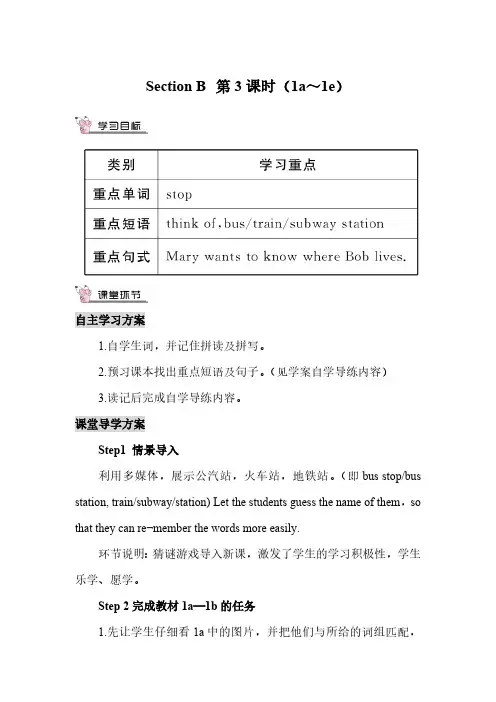
Section B第3课时(1a~1e)自主学习方案1.自学生词,并记住拼读及拼写。
2.预习课本找出重点短语及句子。
(见学案自学导练内容)3.读记后完成自学导练内容。
课堂导学方案Step1 情景导入利用多媒体,展示公汽站,火车站,地铁站。
(即bus stop/bus station, train/subway/station) Let the students guess the name of them,so that they can re¬member the words more easily.环节说明:猜谜游戏导入新课,激发了学生的学习积极性,学生乐学、愿学。
Step 2完成教材1a—1b的任务1.先让学生仔细看1a中的图片,并把他们与所给的词组匹配,并熟记这些词组。
(2分钟)2.分组练习。
结合实际情况讨论上学的交通方式。
(5分钟)参考案例:3.小结训练。
(2分钟)(1)This bus stop (车站)is near the supermarket.(2)The train station (车站)is next to the library.Step 3完成教材1c—1e的任务1.浏览1c中的五个句子,弄懂它们的意思,并注意特殊疑问句后面的语序,为听力做好准备。
(3分钟)2.认真听录音,找出Mary想知道的事情。
(2分钟)3.再听一遍录音,找出Bob去祖父母家所乘的交通工具。
(2分钟)4.听录音,并跟读,模仿语音语调。
(2分钟)5.让学生利用1d中的信息两人一组来讨论Bob 是怎样到达祖父家的。
(分钟)6.小结训练。
(分钟)A:I want to know how you get to school.B:First,I walk (走)to the bus stop,and I take a bus (乘公汽)to the bank. Then I get to my school by boat(乘船).A:How far (多远)is tt ?B:It,s10 kilometers(10 公里).A:How long (多长时间)does tt take you to get to your school?B:Thirty minutes (三十分钟).A:What do youthink of (认为)the trip?B:It takes me too long to get to my school.Step4 问题探究(1)— What do you A the book?— It’s very interesting,I like it.A. think ofB.think upC. think overD.think(2)I want to know C .A. how does he get to schoolB .what time he get to schoolC .what time he gets to schoolD.what he does likeStep 5 家庭作业完成课后提升作业(学案p. 17)教学反思本课时利用多媒体展示图片的方式导入新课,充分调动了学生的兴趣。

七年级英语下册Unit3 How do you get to school?
Section B(2a—2c)
课程设计
【设计思想】
本单元的核心教学内容是谈论学生上学的交通方式。
要求通过学习有关的短语及句型能够训练学生捕捉细节信息的能力和叙述复杂事情的能力。
教学目标
知识目标(1)重点词汇
(2)学会解决阅读题的答题方法
技能目标(1)培养学生的预测能力
(2)训练学生的理解水平
(3)训练学生的语言知识的学习-对形容词、副词的学习与巩固。
情感态度价值观(1)学习内容贴近生活,易激发学生学习英语的兴趣,使他们乐于参与各种英语实践活动。
(2)培养同学们之间互相帮助、团结友爱的精神。
教学重点、难点
重点:利用语境学习生词。
难点:熟练掌握本单元与交通出行相关的词汇和表达。
采用Discussion 的学习策略,利用课件等来展开课堂的形式predict what’s the passage about ,read and translate it 。
教学步骤。
七年级英语下册第三单元教案(新目标英语)Unit3whydoyoulikekoalas?单元整体说明(一)单元教材分析本单元的核心话题是描述动物和表达个人喜好,以及句式whydoyoulike…?Because…。
这也是本单元的教学重点。
通过本单元的学习,学生应能较流利地运用所学词汇和句型描述动物,表达个人喜好。
(二)单元知识结构.词汇动物名称tiger,elephant,koala,dolphin,etc.词汇描述性形容词:smart,cute,ugly,clever,shy,etc.国家名:Australia,SouthAfrica2.句型whydoyoulikekoalahears?Becausetheyarecute.wherearepandasfrom?They'refromchina.whatanimalsdoyoulike?Ilikedolphins.(三)单元整体目标.masterthevocabulary2.masteranduse:whydoyoulikekoalas?Becausetheyamcute.wherearepandasfrom?They'refromchina.whatanimalsdoyoulike?Ilikedolphins.(四)单元教学重难点一览重点难点.thevocabulary2.ThesentencestructuresTheuseofthesentencestructures(五)单元学情分析学生此前已经学过由why,where,what引导的特殊疑问句句型,具有了学习本单元知识的认知前提。
形形色色的动物能激发学生的好奇心,产生了解它们的欲望,这有利于本单元知识的教学和学生学习兴趣的培养。
(六)单元教学建议充分利用简笔画,教学图片,多媒体等教学手段和工具,创设谈论动物的情景,使学生能有尽量多的机会动口说,动笔写,以熟练掌握所学知识,提高听、说、读、写的综合素质。
人教新目标七年级英语下册Unit3SectionB-教案Unit 3 How do you get to school?Section B 1a–1eTeaching aims (教学目标)1. 学习stop 和station.2. 学会表达同时使用多种交通工具去某个地方。
3. 能熟练使用how, how far 和how long 进行操练。
4. 理解听力材料。
Language points (语言点)1. 词汇:1) 名词n. stop2) 短语. think of2. 句型:I ride my bike to the subway station. Then I take the subway. Mary wants to know how far he lives from his grandparents’ home.Difficulties (教学难点)乘坐多种交通工具到达某个地点的表达方法。
Teaching steps (教学步骤)1. Warm-up and revision(课堂热身和复习)(1)Make conversations with your partner.How …/How long …/How far …(2) Read the sentences in Grammar Focus aloud.How do you get to school?How does she get to school? I ride my bike. She usually takes the bus.It takes about 15 minutes. How long does it take to get to school?How far is it from your home to school? It’s only about two kilometers.Does Jane walk to school? No, she doesn’t. She goes by bike.Do they take the bus to school? No, they don’t. They walk.【教学设计说明】通过对话的形式进行热身,可以很好的复习Section A所学重点句型;通过听写句子了解学生掌握句子的情况。
Unit 3 How do you get to school?Section B 1a-2c一、教学目标:1. 语言知识目标:1) 能掌握以下单词:drive, live, stop, think of, cross, river, many, village, villager, between, between…and…, bridge, boat, ropeway, year, afraid, like, dream, come true2) 表达采用怎样的交通方式去某地:Well, I ride my bike to the subway station.Then I take the subway.3) 阅读短文,获取相关信息的能力。
2. 情感态度价值观目标:了解东西方国家出行方式的不同,以及不同的交通规则,教育学生注意交通安全,加深对交通知识的了解。
倡导自觉遵守交通法规及礼貌,构建和谐的人际关系。
了解交通的发展,培养创新精神。
二、教学重难点1. 教学重点:1) 通过进行听、说的训练,来提高学生们综合运用所学知识的能力。
2) 通过读、写的训练,来让学生们能真正在实际活动中运用所学的知识。
2. 教学难点听力训练与阅读训练。
三、教学过程Ⅰ. Warming- up and revision1. Greet Ss as usual.2. Check the homework.Ⅱ. Presentation1. 我们来认识几个新单词。
I'll show you some pictures on the screen. Let's learn some new words.(在屏幕上展示p16页的图片)2. Ss read and try to remember the new words and expressions.Ⅲ. MatchT: 1. Let’s open our books at page 16, point out the blank line in front of each numbered phrase. Ask Ss to match each phrase with a picture by writing the letter of the picture in the bank in front of the correct word. One has done for students.2. Check the answers.Ⅳ. Pair work1. First ask two students to read the dialogue to the class.Sa: How do you get to school?Sb: Well, I ride my bike to the subway station. Then I take the subway.2. Suppose you use two kinds of transportation to get to school. Tell your partner how you get ot school.3. Ss practice the conversations in pairs.4. Let some pairs to act out their conversations.Ⅴ. Listening1c:1. Ask different Ss to read each line to the class.2. Play the tape for the Ss to listen and check the things Mary wants to know.3. Get Ss finish the listening task then check the answers.1d:1. Listen again. How does Bob get to his grandparents' home? Check 1 or2.2. Play the tape twice for the Ss to listen and check.3. Check the answers.Ⅵ. Talking1. Let students tell how Bob gets to his grandparents' home. Ask students to use the pictures in 1d.And write these sentences on the blackboard.First he … Next he… Then he… Finally…2. Ss work with their partners. Try to say how Bob get to his grandparent's home.3. Check the answers.Ⅶ. Guess1. Look at the picture and title below. Guess what the passage is about.T: I think it's about how some students get to school. What do you think?S1: I think it's about how some students in the village get to school.S2: I think it's about how some students in the mountain get to school.Ⅷ. Reading1. Fast readingRead the passage and find the answer to this question:What's the stud ents’ and the villagers’ dream in this village?Ss read the passage quickly and find the answer to this question:Their dream is to build a bridge.2. Careful readingRead the passage again and find the answers to the questions below:1. How do the students in the village go to school?2. Why do they go to school like this?3. Does the boy like his school? Why?4. What is the villager's dream? Do you think their dream can come true?阅读指导:首先,读这四个问题,记住这四个问题。
人教版新目标七年级英语下册 Unit 3说课稿一. 教材分析人教版新目标七年级英语下册Unit 3的主要内容包括:课本上的对话和课文,以及相关的词汇、语法和练习。
本节课的主要话题是谈论日常生活,通过学习本节课,学生可以掌握一些与日常生活相关的词汇和表达方式,以及一般过去时的用法。
二. 学情分析七年级的学生已经掌握了基本的英语语法和词汇,但他们的英语听说能力还不够强。
因此,在教学过程中,我们需要注重培养学生的听说能力,让他们能够在实际生活中运用英语。
三. 说教学目标1.知识目标:学生能够掌握日常生活中常用的词汇和表达方式,理解并运用一般过去时。
2.能力目标:学生能够听懂、会说日常生活中的对话,提高他们的听说能力。
3.情感目标:通过学习本节课,学生能够激发对英语学习的兴趣,培养积极的学习态度。
四. 说教学重难点1.教学重点:学生能够掌握日常生活中常用的词汇和表达方式,理解并运用一般过去时。
2.教学难点:学生能够听懂、会说日常生活中的对话,并能够在实际生活中运用。
五. 说教学方法与手段1.教学方法:采用任务型教学法,让学生在实际操作中学习英语,提高他们的实践能力。
2.教学手段:利用多媒体课件、图片、卡片等辅助教学,激发学生的学习兴趣。
六. 说教学过程1.导入:通过与日常生活相关的话题引入本节课,激发学生的学习兴趣。
2.新课呈现:通过展示图片、多媒体课件等方式,展示本节课的主要内容,让学生初步感知。
3.讲解与练习:讲解日常生活中常用的词汇和表达方式,并通过练习让学生巩固所学知识。
4.对话练习:分组进行对话练习,让学生在实际操作中学会运用英语。
5.课堂小结:对本节课的主要内容进行总结,让学生明确所学知识。
七. 说板书设计板书设计要简洁明了,能够突出本节课的主要内容。
可以设计成思维导图的形式,将日常生活中常用的词汇和表达方式以及一般过去时的用法进行板书。
八. 说教学评价教学评价可以通过学生的课堂表现、作业完成情况和对话练习来进行。
七年级下英语Unit 3 How do you get to school?sectionB词汇与语法1.词汇篇:Stop-- stopping cross --across river-- by riverMany—more- most village _- villager --- in the village -- from a village Between- among bridge- on the bridge—cross the bridgeBoat – by boat -- on/in a boatLike -- love --dislike leave--- leave for -- leave from Dream—dreamful—dreamland—dreamlikeTrue—truly –come true small- big china chineseDifficult-difficulty-difficultlyQuick-quickly class classmate classroom2重点语法3、 listen to, hear和sound△listen to意为“注意听”,强调听的动作。
e.g 他们在听老师说。
△hear意为“听见”,强调听的结果。
如:△sound意为“听起来,听上去”,可作系动词+形容词这个故事听起来很有趣1 ____ the radio, it says the flood is coming soon.2 I can’t____ you , because there’s something wrong with my ears.3 What you said ____ interesting.How far is it from your home to school?这个句型用来询问两地间的距离。
How far is it?=How far is it from here? =how far is from here?回答, it is +距离e.g —How far is your house from the school?你家离学校有多远?—It’s about 2 kilometers. /It’s about 20 minutes’ walk.、how far 用来提问距离,意为“多远。
How far is it from A to B?=How far is B from A? A 到B有多远?①用长度单位表示eg: —— How far is it from your home to the bus stop ?——It’s five kilometers.②用时间表示eg: —— How far is the park from the shop ?——It’s ten minutes’ walk.How long / How farA地离 B地有多远:It is + 距离 + from A地 to B地 = A地 is + 距离 + from B地1.我家到学校10公里。
It’s 10 kilometers _________my home________ school.= My home is 10 kilometers _____________ school.2.It’s 10 kilometers from the bus station to school.= The bus station _________ 10 kilometers ______________________ school.3.The hospital is 5 kilometers from school.= It’s 5 kilometers ___________ the hospital ____________ school.4.离车站8英里。
It’s 8 miles ____________the train station.= The train station is 8 ____________ from here.5.离学校8 英里。
It’s 8 miles ____________the school.= The school is 8 ____________ from here.6.有多远?How ______is it ?7.离学校有多远?______ ______ is it _______school?8.你住的地方离学校有多远?How __________ do you live _________ school?9.她住的地方离学校有多远?How ________ ________ she live ________ school?3、spend, cost, pay 与take区别(1)on sth或spend…(in) doing sth.意为“某人花时间/金钱做某事”。
.(2)coststh cost sb some money意为“某物花费某人多少钱”。
eg: 这条连衣裙花了我五十元。
(3)paysb pay money for sth.意为“某人为某物付款”。
eg:我的爸爸花了1000块买这个电话。
(4)takeIt takes sb time/to do sth. 花某人多长时间做某事。
eg: 我花了三个小时做我的家庭作业。
It_____ them three years to build this road.A new computer_____ a lot of moneyThey____ two years (in) building this bridgeI _______ two hours on this maths problem1. I have to _____ them 20 pounds for this room each month.A. payB. paidC. costD. took2. They spend too much time _____ the reportA. writingB. to writeC. on writingD. write3. --What beautiful shoes you’re wearing! They must be expensive . --No,they only_____l0 yuan.A.spent B.took C.paid D.cost4. --Will you please ____ for my dinner, Peter? --Sure!A. spendB. payC. costD.take5. It will ____me too much time to read this book.A. takeB. costC. spendD.pay6.This science book ____ me a great amount of money.A. tookB. costC. usedD. spenttake…to…意为“把…带去…”bring….to….把…带来take sb/sth to sp take sb/ sth to sb把。
带到某地或带到某人那bring sth/sb to sp /sb, 把。
带来到。
bring sth/sb from sb/sp把。
从。
带来e,g 我把我的妹妹带到了我的爷爷那我从学校带回了我的儿子。
how long 用来提问时间,意为“多久与how 有关的特殊疑问词,1.用来询问方式或手段。
How are they going to Poland? 他们怎样去波兰?2.用来询问程度。
How is your weekend? 周末过得怎样?3.用来打招呼、问候或询问身体情况。
How are you? 你好。
4.how old提问年龄。
How old is Cindy? Cindy多大了?5.how much提问不可数名词的数量,还可用于提问价钱。
How much milk do you want? 你要多少牛奶How much is your shirt? 你的衬衫多少钱?6.how many提问可数名词的数量,后接可数名词的复数。
How many birds are there in the tree? 树上有几只鸟?7.how far 提问路程的距离。
How far is the nearest post office? 最近的邮局有多远?8.how long提问时间的长短,还可用于提问物的长度。
--How long did you stay in Guangdong?--Since two months ago.你在广东住了多长时间?大约两个月。
How long is the river in front of my house? 我家门前的小河有多长?9.how often提问事情发生的频率。
--How often does she go to the English club?--Once a week.她多久去一次英语俱乐部?每周一次。
10.how soon提问多久之后,用于将来时。
--How soon will you be back? --In two weeks. 你多久以后能回来?两个月后。
11.how about用于提出建议或征求对方的意见,与what about一致,肯定回答可用OK/All right/Good idea等,否定回答可用Sorry并陈述理由。
How about this blue bike? It is cheaper. 这辆蓝色的自行车怎么样?它便宜些。
1 _______ do you play sports? --Three times a week.2_______ will you parents be back? --In two weeks3________ hamburgers do you want? --Three.4________ milk do you need?5________ is your T-shirt?6_________ does it take to get to school? --About 15 minutes.7___________ is this ruler? --About 20 centimeters.8 —_________ is the bike?—Just $ 150.A.How muchB. How manyC. How longD. How often9 —_______do you help the old man with the housework?—Once a week.A. How soonB. How longC. How oftenD. How many10 —______is it from our school to Jingzhu Mall?—About half an hour's walk. Shall we go there?A. How farB. How oftenC. How longEvery day everydayEvery day 每天everyday adj每天的,日常的E,g 我们每天学习日常英语。